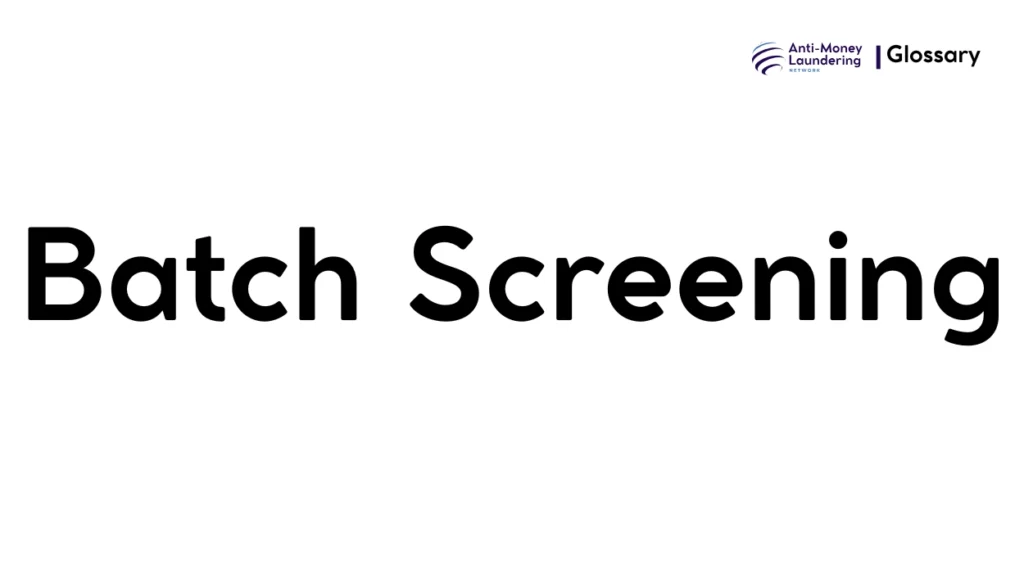Batch Screening is a critical component in the fight against money laundering, designed to help financial institutions maintain robust compliance programs. In this detailed guide, we will explore its definition, regulatory basis, practical application, implementation procedures, and more. This overview is tailored for compliance officers and financial institutions seeking to strengthen their AML frameworks.
Definition
Batch Screening in Anti-Money Laundering (AML) refers to the process where an institution performs a systematic, periodic check of its entire customer or entity database against updated watchlists, sanctions lists, and other relevant databases to identify potential matches. Unlike real-time screening performed at onboarding or transaction time, batch screening is conducted on a schedule (daily, weekly, or monthly) to detect emerging risks after initial onboarding.
Purpose and Regulatory Basis
Purpose
Batch Screening serves as an ongoing monitoring mechanism to detect customers who may have become risky over time due to updated regulatory watchlists or adverse information. It ensures institutions do not rely solely on initial checks but maintain effective surveillance to prevent financial crimes.
Regulatory Basis
Globally, regulatory frameworks mandate ongoing monitoring as part of AML obligations. Key regulations and standards include:
- Financial Action Task Force (FATF) Recommendations: Emphasize continuous monitoring of business relationships.
- USA PATRIOT Act: Requires enhanced due diligence and ongoing monitoring to prevent terrorist financing.
- EU’s 6th Anti-Money Laundering Directive (AMLD6): Mandates periodic screening against updated sanctions and politically exposed persons (PEP) lists.
Batch screening aligns with these regulatory requirements by enabling institutions to detect changes in a customer’s risk profile promptly.
When and How It Applies
When It Applies
- Regular scheduled intervals: daily, weekly, or monthly, depending on institutional risk appetite and jurisdictional mandates.
- Triggered by updates in sanctions lists, PEP lists, or adverse media indicating new risks.
- In response to changes in customer data (e.g., name changes or new affiliations).
Real-World Use Cases
- Re-screening existing customers after global sanctions updates.
- Screening entire portfolios after mergers or acquisitions.
- Batch processing large files of new customers gathered through bulk onboarding.
Types or Variants
1. Name Screening Batch
Screening customer names against sanctions, PEP, and watchlists to detect identity matches.
2. Transaction Batch Screening
Though more often real-time, some institutions batch-screen transaction data periodically for suspicious activities.
3. Adverse Media Screening
Batch searches for negative news or associations linked to customers or entities.
Procedures and Implementation
Steps for Compliance
- Data Collection and Preparation: Gather and cleanse customer data into standardized formats (e.g., CSV files).
- List Management: Maintain current and comprehensive watchlists, sanctions lists, PEP databases, and adverse media sources.
- Batch Screening Execution: Upload customer data into AML screening software capable of batch processing.
- Hit Review and Analysis: Compliance teams analyze and adjudicate alerts to eliminate false positives.
- Documentation and Reporting: Record actions and decisions for audit trails.
- System Integration: Automate batch scheduling using APIs or built-in tools.
Systems and Controls
- Use automated screening solutions with fuzzy matching and AI to minimize false positives.
- Implement threshold tuning to balance sensitivity and alert volume.
- Ensure data quality controls to avoid errors.
Impact on Customers/Clients
- Customers may be subject to routine background checks without direct interaction unless an alert triggers additional scrutiny.
- Screening is conducted respecting privacy and data protection laws.
- When flagged, customers may face enhanced due diligence, potential restrictions, or temporary holds pending resolution.
Duration, Review, and Resolution
- Batch screenings are recurring and ongoing throughout the customer lifecycle.
- Alert reviews must be timely, generally within a regulator-defined window (e.g., 48-72 hours).
- Resolution involves either clearing the customer or escalating for enhanced due diligence or reporting.
Reporting and Compliance Duties
Institutions are responsible for:
- Maintaining comprehensive documentation of screening processes and alert adjudications.
- Reporting suspicious activity findings to relevant authorities (e.g., SAR filings).
- Implementing controls to adhere strictly to regulatory timelines and risk appetite policies.
- Ensuring internal audit and external regulator examinations have access to batch screening records.
Related AML Terms
- Real-Time Screening: Instant checks at onboarding or transaction execution.
- Customer Due Diligence (CDD): Verification during onboarding.
- Enhanced Due Diligence (EDD): Additional scrutiny for high-risk customers.
- Politically Exposed Persons (PEPs): Individuals with higher AML risk.
- Sanctions Lists: Legally binding lists prohibiting dealings with certain parties.
Challenges and Best Practices
Challenges
- High false positive rates leading to alert fatigue.
- Data inaccuracies (misspellings, outdated info).
- Managing updated and comprehensive watchlists.
- Balancing thoroughness with operational efficiency.
Best Practices
- Use advanced algorithms with fuzzy matching and AI technologies.
- Regularly update and validate customer and watchlist data.
- Prioritize alerts based on risk scoring.
- Train staff adequately for efficient review and decision-making.
- Automate scheduling to ensure no missed screenings.
Recent Developments
- Integration of Artificial Intelligence and Machine Learning to improve matching accuracy.
- Adoption of cloud-based batch screening solutions for scalability and speed.
- Regulatory emphasis on risk-based approach driving customized batch screening frequencies.
- Enhanced cooperation between jurisdictions to update watchlists in real time.
Batch Screening is indispensable for robust AML programs, ensuring ongoing vigilance beyond initial onboarding. It enables financial institutions to detect emerging risks by systematically re-evaluating their customer base against constantly updated regulatory lists and intelligence. Implementing effective batch screening processes and technologies safeguards institutions from exposure to financial crime, helps comply with global regulatory mandates such as FATF, USA PATRIOT Act, and EU AMLD, and ultimately supports the integrity of the financial system.

